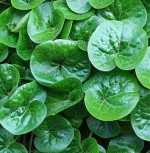 Asarum is a genus in the pipevine family, Aristolochiaceae, and includes about sixty species including several that are considered garden worthy plants. It acquired the common name, wild ginger, because the rhizome tastes and smells like ginger root when crushed or bruised, but it is not related to true ginger. Plants are low-growing and native to woodlands of north temperate areas of the Northern Hemisphere. Creeping rhizomes produce one to three glossy kidney-shaped leaves on long petioles. The urn-shaped flowers appear singly in spring at ground level between two leaves and are often hidden by the foliage. They are fleshy, usually purplish-brown, and have three flaring lobes that are rounded or drawn out to long points. Wild ginger is frequently grown as a ground cover. Most species prefer dense shade, and consistently moist, well-drained, slightly acidic soil. Propagation is by seed or division in spring or early fall. Snails and slugs are major problems.
Asarum is a genus in the pipevine family, Aristolochiaceae, and includes about sixty species including several that are considered garden worthy plants. It acquired the common name, wild ginger, because the rhizome tastes and smells like ginger root when crushed or bruised, but it is not related to true ginger. Plants are low-growing and native to woodlands of north temperate areas of the Northern Hemisphere. Creeping rhizomes produce one to three glossy kidney-shaped leaves on long petioles. The urn-shaped flowers appear singly in spring at ground level between two leaves and are often hidden by the foliage. They are fleshy, usually purplish-brown, and have three flaring lobes that are rounded or drawn out to long points. Wild ginger is frequently grown as a ground cover. Most species prefer dense shade, and consistently moist, well-drained, slightly acidic soil. Propagation is by seed or division in spring or early fall. Snails and slugs are major problems.
European Wild Ginger (A. europeum)
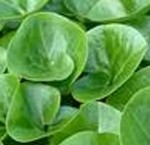 Evergreen heart-shaped leaves are leathery, glossy, dark green and two to three inches wide. They may be slightly mottled, have wavy margins and are produced in pairs on petioles five to six inches long. An excellent choice for a ground cover in cool area but does not do well in the heat and humidity of the South.
Evergreen heart-shaped leaves are leathery, glossy, dark green and two to three inches wide. They may be slightly mottled, have wavy margins and are produced in pairs on petioles five to six inches long. An excellent choice for a ground cover in cool area but does not do well in the heat and humidity of the South.
Size: 5-6” H x 8-12” W
Leaf Width: 3”
Hardiness: Zones 4-7
Canadian Wild Ginger (A. canadense)
 A native of woodlands in Eastern North America, it has deciduous, kidney-shaped leaves up to seven inches across carried on hairy petioles one inch long. The purplish-brown flowers are one inch across and have long pointed reflexed lobes. The rhizomes are more aromatic than those of European ginger and plants are more tolerant of heat.
A native of woodlands in Eastern North America, it has deciduous, kidney-shaped leaves up to seven inches across carried on hairy petioles one inch long. The purplish-brown flowers are one inch across and have long pointed reflexed lobes. The rhizomes are more aromatic than those of European ginger and plants are more tolerant of heat.
Size: 6” H x 8-12” W
Leaf Width: 6”
Hardiness: Zones 2-9
British Columbia Wild Ginger (A. caudatum)
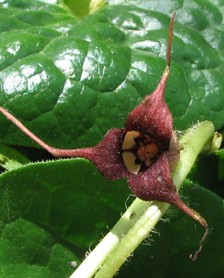 This western wild ginger is native to the area from British Columbia to California and west to Montana. It is semievergreen except in cold areas and has a creeping habit, forming large mats. The leaves are paired, two to four inches long by up to seven inches wide, and have hair along the veins on the underside. The flower lobes are extended into long tails, giving rise to the specific epithet, caudatum, from the Latin word for tail.
This western wild ginger is native to the area from British Columbia to California and west to Montana. It is semievergreen except in cold areas and has a creeping habit, forming large mats. The leaves are paired, two to four inches long by up to seven inches wide, and have hair along the veins on the underside. The flower lobes are extended into long tails, giving rise to the specific epithet, caudatum, from the Latin word for tail.
Size: 7-9” H x 8-12” W
Leaf Width: 7”
Hardiness: Zones 6-9
Cyclamen-Leaved Ginger (A. hatwegii)
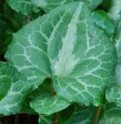 Endemic to California this wild ginger has five inch wide leaves marbled with silver along the veins and carried on eight inch petioles. The flowers are similar to those of A. caudatum.
Endemic to California this wild ginger has five inch wide leaves marbled with silver along the veins and carried on eight inch petioles. The flowers are similar to those of A. caudatum.
Size: 4-6” H x 12” W
Leaf Width: 5”
Hardiness: Zones 5-9
Mottled Wild Ginger (A. shuttleworthii)
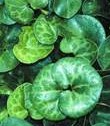 This native of the Appalachian Mountains from Virginia to Georgia has three inch wide leaves that are usually evergreen and may be either solid green or spotted with silver-gray. The two inch wide broad-lipped flowers are vase-shaped and have violet spots inside.
This native of the Appalachian Mountains from Virginia to Georgia has three inch wide leaves that are usually evergreen and may be either solid green or spotted with silver-gray. The two inch wide broad-lipped flowers are vase-shaped and have violet spots inside.
Size: 6-8” H x 8-12” W
Leaf Width: 3”
Hardiness: Zones 7-9
Panda Face Ginger (A. maximum)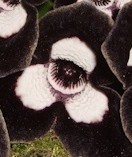 Panda face ginger is native to China where it grows in low elevation forests. The evergreen, shiny, heart-shaped leaves are about three inches long and may be variegated with two silver-green blotches on either side of a central green stripe. The flowers are two inch wide and resemble pandas with their black and white coloring. Does well as ground cover or in containers.
Panda face ginger is native to China where it grows in low elevation forests. The evergreen, shiny, heart-shaped leaves are about three inches long and may be variegated with two silver-green blotches on either side of a central green stripe. The flowers are two inch wide and resemble pandas with their black and white coloring. Does well as ground cover or in containers.
Size: 3-6” H x 8-12” W
Leaf Width: 3”
Hardiness: Zones 7-9